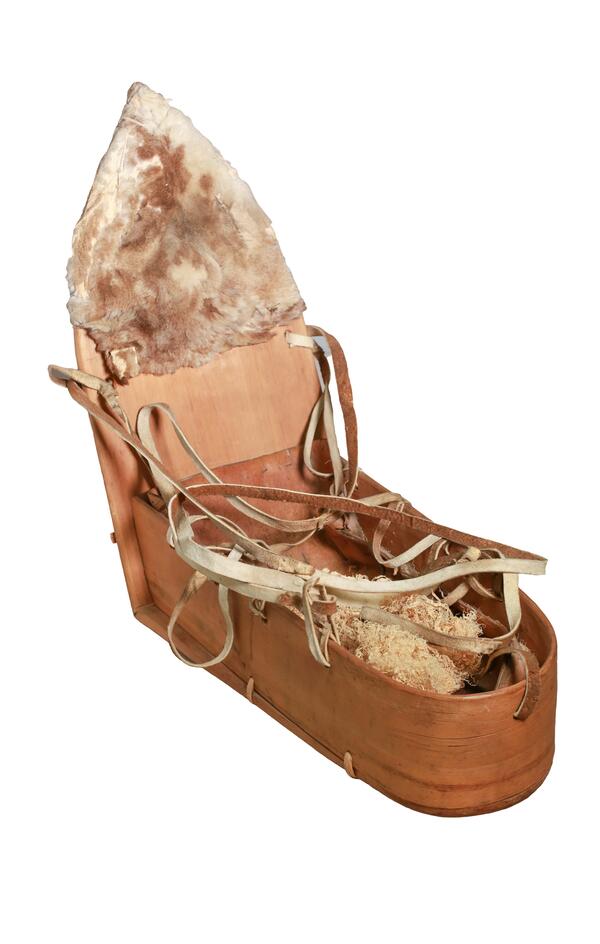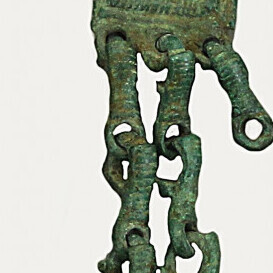In the old days, the Khanty believed that many events of a person’s life were connected with the spirit world. Such events included the birth of a child. According to the Yugan Khanty, at first, the baby does not belong to the human world and can leave at any time. Cradles were made from birch bark to keep the baby in the human world.
There were two types of cradles for children: day and night cradles. They differed both in material and in form. If it was the first child in the family, then the midwife, who delivered the baby, made the night cradle from birch bark for him, and the mother made the cradle for the subsequent children. The birch bark as the material was not chosen by chance: magic properties were attributed to it. It was believed that the birch bark separated the human world and the spirit world. This function of birch bark is also reflected in the Salym folklore: in the epic poetry, heroes lived behind a birch bark partition separating them from the world of people.
The day cradle was first used when the child was three months old. The child’s father made it, but the creation was entrusted to a third person if he could not do it. The cradle was made from a “living” tree: the wood was cut off from pine or cedar while trying not to touch the wood core so that the tree would continue to grow at the same time as the child. Coniferous parts were used for the bottom and back of the cradle, and birch was used for the sides since it bends well.
Holes for straps were made in the upper part of the sides and along the edges of the back. A cradle was hung from the ceiling of the dwelling or to a pole stuck into the ground at an angle. It was installed so that the cradle with the child was always within the view of adults. The straps also served to carry a cradle on the shoulder. In the folklore of the Yugan Khanty, the fire had a protective function; therefore, a cradle was hung in a dwelling between a bunk and a chuval — a traditional stove of the Eastern Khanty. The Khanty believed that in this case, the child is under the protection of fire.
On the back of the day cradle, the Yugan Khanty depicted a cross: in pre-Christian ideas, it served as a symbol of the transition from one state to another. The back of the cradle was covered with deerskin. Thin birch bark liners were inserted into the cradle, which in shape resembled a night cradle. They were filled with softwood shavings — “chip” — or birch wood rot. The shavings were used instead of diapers, then they were discarded under an old stump at the edge of the village, and charcoal from the hearth was placed on top as a talisman. Shavings and wood rot were not thrown under a living tree. It was believed that it could sway and disturb the soul of a child.
A day cradle is exhibited at the Museum of the Ob River. It was made in the 1970s.
There were two types of cradles for children: day and night cradles. They differed both in material and in form. If it was the first child in the family, then the midwife, who delivered the baby, made the night cradle from birch bark for him, and the mother made the cradle for the subsequent children. The birch bark as the material was not chosen by chance: magic properties were attributed to it. It was believed that the birch bark separated the human world and the spirit world. This function of birch bark is also reflected in the Salym folklore: in the epic poetry, heroes lived behind a birch bark partition separating them from the world of people.
The day cradle was first used when the child was three months old. The child’s father made it, but the creation was entrusted to a third person if he could not do it. The cradle was made from a “living” tree: the wood was cut off from pine or cedar while trying not to touch the wood core so that the tree would continue to grow at the same time as the child. Coniferous parts were used for the bottom and back of the cradle, and birch was used for the sides since it bends well.
Holes for straps were made in the upper part of the sides and along the edges of the back. A cradle was hung from the ceiling of the dwelling or to a pole stuck into the ground at an angle. It was installed so that the cradle with the child was always within the view of adults. The straps also served to carry a cradle on the shoulder. In the folklore of the Yugan Khanty, the fire had a protective function; therefore, a cradle was hung in a dwelling between a bunk and a chuval — a traditional stove of the Eastern Khanty. The Khanty believed that in this case, the child is under the protection of fire.
On the back of the day cradle, the Yugan Khanty depicted a cross: in pre-Christian ideas, it served as a symbol of the transition from one state to another. The back of the cradle was covered with deerskin. Thin birch bark liners were inserted into the cradle, which in shape resembled a night cradle. They were filled with softwood shavings — “chip” — or birch wood rot. The shavings were used instead of diapers, then they were discarded under an old stump at the edge of the village, and charcoal from the hearth was placed on top as a talisman. Shavings and wood rot were not thrown under a living tree. It was believed that it could sway and disturb the soul of a child.
A day cradle is exhibited at the Museum of the Ob River. It was made in the 1970s.


